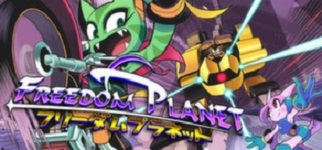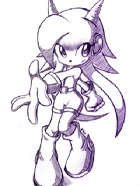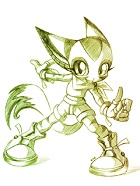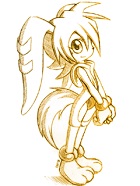'Freedom Planet': a furry platformer inspired by furry platformers
 What would happen if Sonic the Hedgehog and Sparkster from the the Sega Genesis game Rocket Knight Adventures had a love child? Well, apparently it would produce a purple dragon.
What would happen if Sonic the Hedgehog and Sparkster from the the Sega Genesis game Rocket Knight Adventures had a love child? Well, apparently it would produce a purple dragon.
Most people would point out that this makes absolutely no biological sense. They’d be right. I was talking metaphorically about game mechanics.
Yes, Freedom Planet is a platformer featuring anthropomorphic characters in high speed platforming antics. There are certainly plenty of those to go around. But what makes this one stand out is that it really does capture the essence of what made those titles that inspired it successfully, all while creating a style of its very own.
The Sonic-like aspects
When most people saw the premise for this game, Sonic is probably the first thing that came to mind. The loops, the running speed, the characters with big-eyed large heads. Indeed, these are all there &ndash along with an antagonist who has a jutting set of red facial hair who wants to use his mechanical army to take over the universe.
Well okay, that last part is not fair. This antagonist is evil with a capital E and not the mess that Eggman has become. The evil space lord is also smarter than the doctor because he seems to understand how to use the political environment to manipulate things so he doesn’t have to do everything himself. Oh, and his robot companion is actually funny, but sort of stepping in GLaDOS territory to do so.
 You get to play three protagonists; as in the old Sonic games, each offers a different experience. I found the most interesting aspect of these is that they seemed to base themselves more on the RPG class stereotypes than any of the Sonic character tropes.
You get to play three protagonists; as in the old Sonic games, each offers a different experience. I found the most interesting aspect of these is that they seemed to base themselves more on the RPG class stereotypes than any of the Sonic character tropes.
Lilac, the purple dragon, is like the warrior class character. I hardly see her resemblance to a dragon. She can dish out damage to the stronger enemies more quickly than the other characters. She is the leader of the group and tends to be the one to be quickest to take action, to the dismay of her friend Carol who calls her “Ms. Heropants” when she starts to.
 Carol, the green wild cat, is the thief/ninja class character. She can deal damage quickly, but takes more strikes to down opponents. She also has access to a motor bike and wall-jumping platforms. She’s a bit snarky and energetic, not respecting authority in the way others might. She is loyal to her friend, but sometimes her annoyance causes her to get into dangerous and troubling situations.
Carol, the green wild cat, is the thief/ninja class character. She can deal damage quickly, but takes more strikes to down opponents. She also has access to a motor bike and wall-jumping platforms. She’s a bit snarky and energetic, not respecting authority in the way others might. She is loyal to her friend, but sometimes her annoyance causes her to get into dangerous and troubling situations.
 The hardest character to play, unlocked by playing some of the main campaign, is Milla. Milla is the mage-like character, as you have to use her abilities to attack enemies and she can take far less damage than the others. She’s shy, aloof, and a bit random. However, she has a good sense of the environment around her. Playing as her gives you a unique first level which shows that you have to play much differently with her than the other two characters.
The hardest character to play, unlocked by playing some of the main campaign, is Milla. Milla is the mage-like character, as you have to use her abilities to attack enemies and she can take far less damage than the others. She’s shy, aloof, and a bit random. However, she has a good sense of the environment around her. Playing as her gives you a unique first level which shows that you have to play much differently with her than the other two characters.
There is also water and the capacity to drown; however, it’s not as much a threat as in Sonic games for two reasons. Firstly, all three characters can swim. Secondly, they modified the air bubble mechanic so that if you stand on the bubbles you will get air without having to wait for a big bubble to show up. Quite honestly it’s probably a better way to do it for the player, as it avoids the infamous problem of rolling the dice on waiting at the air bubble.
There are shields which protect against fire, prevent drowning in water, attract gems, and attract health petals.
The Rocket Knight-like aspects
After playing the game and getting a feel for the style of play, one thing dawned on me quite quickly. While on the surface the game could be seen to many as a Sonic-clone or Sonic-like game, I was much more reminded of Rocket Knight in how it played. Here are the traits which made me start thinking that this was the dominant parent in the inspiration for this game.
The way the bosses are handled in this game is far more Rocket Knight than Sonic. Bosses are large and sleek; fighting them is an intricate dance. They also tend to let their presence be known throughout the level to give you a sense of anticipation.
What I will say next might be a bit controversial, but boss fights were never Sonic’s strongest suit, and they’re getting worse over time. Most are simple affairs with one or two stages and very few ever force you too much on the defensive. If there is difficulty, it’s more likely because they only let you get hit once because they didn’t give you any rings.
In Freedom Planet, most of the bosses may very well kill you the first few times you fight them. Most have patterns, like those in this genre tend to; however, some of them have “move sets” instead – a set of attacks they can and will use when they feel like it. As the boss gets into a deeper stage they’ll add a new move to the set. Why does this make them more challenging? Depending on the move they use, you may want to attack or evade, and you may only have a few moments to decide which. Knowing what decision to make you have to learn, and learning means taking hits for your mistakes.
The emphasis and pleasure of fighting the bosses is something I really liked about the first Rocket Knight, and the way the bosses were handled very much reminded me of this.
The health system is also more like the armadillo’s game, with petals representing your life, and collectable gems to gain additional lives. Lives, however, (at least in Normal difficulty) are meaningless as far as I can tell. Both dying and getting a Game Over will end with you going to the last checkpoint. So then what’s the point of collecting gems? No idea. Score, probably.
Above your health meter is a special bar which indicates you can use your special move. Sound familiar? These moves can take a little or the entire bar depending on their power. Knowing how much power you have (and when to use it) comes into play during the intensity of boss battles. You could attack the boss when he’s using this move, but you don’t have the energy to do the most damage, and your health is running low. Do you go in and risk the weaker strikes? Do you wait until they do it again, but risk getting killed meanwhile? This tracking of the power charge timing and deciding how to make best use of it adds a layer that makes this more Rocket Knight than Sonic.
Other aesthetics
Graphics
The arenas and characters are colorful, but also tastefully shaded. The sprites are well-animated, and each character’s flow feels natural despite their distinct differences. The frame rate keeps its consistency even when the screen gets busy, which is important in a speed based platformer.
Music
The main theme, which plays as the invulnerability song, is pretty memorable. The rest of the music, while good, never gave me a case of ear worm. As I write this I can remember the stages, but not the music that played for them. It may not be fair for a good soundtrack to be seen as just average, but this is a furry platformer. For some odd, indiscernible reason, this genre alone raises the stakes for the soundtrack. One might be tempted to blame Sonic, but it goes back to even earlier than that. Even older furry platformers, that are imfamous for getting everything else wrong, still somehow deliver a tune that sticks with you and never leaves! That didn’t happen to me with this game, for some reason or another.
And that might be a good thing if it meant not losing focus on the gameplay.
Voice acting
Okay, so the music probably can’t live up to the Sonic standard of tunes, but the voice acting very much surpasses any of the blue hedgehog’s modern exploits, easily. The voice acting is superbly done. The character’s voices are each distinct. They each fit with exactly how you expect a character that looks like that to sound. Better yet is that they deliver their lines with the right amount of emotion and inflection of their personality at all times. It’s amazing to me how many games, even the top-budgeted ones, get this wrong. So it should be praised. It’s always a shame when a story is gloomed because of terrible delivery.
Narrative
The adventure mode uses an effective form of in medias res. The strength of this narrative style gets the player playing sooner. The take back is that after the second level, when the first act crops back in, the cutscenes get a bit longer. However, they are very enjoyable the first time through. The story is mostly the same for Carole and Lilac, though there are slight differences to what you see. Therefore, it’s probably be recommended to play the adventure mode for both Carole and Lilac at least once. Milla, as far as I know, is not an option for the adventure mode.
For those who don’t like story in their platformer, stick with classic mode, which removes the fluff. But it’s good fluff, and you won’t regret sitting through it. And at least they were thoughtful enough to put in a very easy way to skip it. Unlike DuckTales: Remastered, whose insistence on interrupting game play every few seconds just because they were happy to get the original voice actors and had to put in meaningless dialog that you couldn’t skip without hitting two buttons every time and… oh, I’m getting off topic. Let’s just say I’m glad this game didn’t do that.
Conclusion
Lilac, the game’s main protagonist, has a special attack. This attack uses the whole energy bar and requires the bar to be full to use. When used she will shoot off in the direction you are holding while bouncing off walls; like Sparker’s signature rocketing ability. However, unlike the armadillo she maintains her horizontal momentum when it is finished and before she “rockets” she will curl up into a ball. In that way it reminds me of Sonic’s signature Spin Dash.
Huh. When I said Sonic and Sparkster had a baby I was talking about gameplay mechanics, wasn’t I?
I guess it’s needless to say, but if you loved either Sonic or Rocket Knight, you’ll find much to love about Freedom Planet.

About the author
Sonious (Tantroo McNally) — read stories — contact (login required)a project coordinator and Kangaroo from CheektRoowaga, NY, interested in video games, current events, politics, writing and finance
Furry since 2001.
Flayrah contributor since 2010.
Flayrah editor since 2017.
Runner of Non-Fiction furry YouTube channel "World in Rooview" started in 2017.
Comments
In Lilac the not-very-draconic dragon's defense, how would you know Sonic was a hedgehog if he didn't have "the Hedgehog" appended to his name?
Or Wile E. Coyote was a coyote if it wasn't part of his name?
Wile E. Coyote at least looks like a coyote. Or a wolf or German Shepherd; Chuck Jones' cartoon style made them pretty identical. Sonic -- yeah, Sonic looks more like an alien of some sort rather than a hedgehog. He is big enough to be a porcupine rather than a hedgehog.
Fred Patten
I've seen coyotes. Even those mangy ones rednecks mistake for chupacabras. My dad once rescued an abandoned coyote pup (which he of course named Wile E.).
I'm sorry, I just don't see the resemblance.
To put the boss difficulty in perspective, I died 73 times on the final boss and over the course of a whole hour . So that's a death every 50 seconds on average.
This was on Normal Mode.
Which is ironically about the amount of lives I can accumulate on a single run of Sonic 3 and Knuckles.
So I'll give Lord Baron that, inside or outside his machines, that fuzzy brow can throw down. Bring your perseverance.
Also, funnily while the end credits will tell you how many times you died in each level, if that total goes over 99 it breaks the menu counter as it won't go higher than that.
As an additional note, when talking about Rocket Knight I refer only to the Genesis one, not the XBox/PC release by the same name.
Interesting.. There is another "furry game" inspired by games such as Banjo Kazooie and others, which is called Lobodestroyo.
One of those names that is pretty darn hard to remember. xD
Account abandoned and probably will make a new anonymous account with no trace of evidence of it being me. I think it's justified.
As someone who never liked Sonic, I find this more aesthetically appealing and possessing superior gameplay. A Sonic fan game that plays and looks better than Sonic. Shoot me!
Post new comment